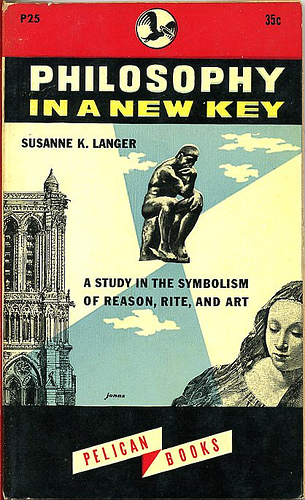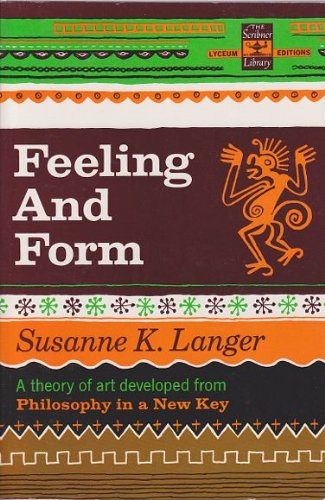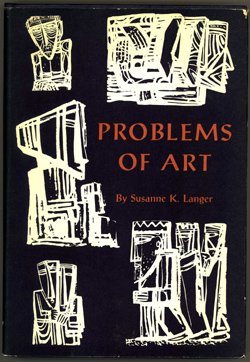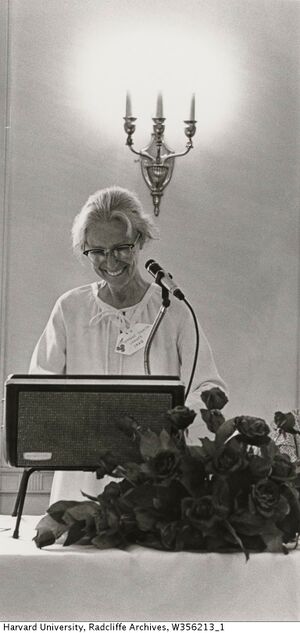Susanne Langer
Susanne Katherina Langer (née Knauth; 20 December 1895, New York, US – 17 July 1985, Old Lyme, Connecticut, US) was a philosopher, writer, and educator. Langer is best remembered for her book Philosophy in a New Key (1942) which was followed by a sequel Feeling and Form: A Theory of Art in 1953.
A long-time resident of Old Lyme and professor of philosophy at Connecticut College in New London, Susanne K. Langer was one of the first women to make an academic career in the field of philosophy and the first to be considered a major American philosopher. Her Philosophy in a New Key and Mind: An Essay on Human Feeling pioneered new concepts in the field of aesthetics.
Born in Manhattan to German immigrant parents, Susan Knauth was raised in a rich intellectual and artistic environment. She attended private schools before entering Radcliffe College, where she graduated with a Bachelor of Arts in 1920. A year later she met and married William L. Langer, a history professor at Harvard. She then earned a Master’s degree (1924) and a Ph.D. (1926) in Philosophy from Harvard. For the next fifteen years she was a professor of philosophy at Radcliffe, Wellesley, Smith, and other colleges while also raising two sons and writing her first scholarly works. Her first book, The Cruise of the Little Dipper and Other Fairy Tales (1924) was a study of myth and fantasy and her first philosophical treatises were The Practice of Philosophy (1930) and An Introduction to Symbolic Logic (1937) .
It was with the 1942 publication of Philosophy in a New Key: A Study in the Symbolism of Reason, Rite, and Art, 1946’s Language and Myth, and her translations of the work of the German philosopher Ernst Cassirer that Langer became known as a leading figure in the philosophy of art. From 1945 to 1950 she taught at Columbia University, where she received a Rockefeller Foundation grant to write Feeling and Form: A Theory of Art, which she published in 1953. In 1954, Langer was named Chair of the Philosophy Department at Connecticut College, where she taught for the rest of her career. In 1960, she was elected to the American Academy of Arts and Sciences. She retired in 1962 as Professor Emeritus, continuing to pursue philosophical thought.
Susanne K. Langer spent her retirement years at her home in Old Lyme, where she dedicated herself to writing Mind: An Essay on Human Feeling, which was published in three volumes (1962, 1972, and 1982) and represents the culmination of her life’s work. She died in Old Lyme in 1985 at the age of 90. Her papers are housed at the Connecticut College Library, where a bronze bust of her was dedicated in 1988.
Philosophy in a New Key, Langer’s best known work, sold over 500,000 copies in her lifetime, making it one of the all-time bestsellers of Harvard University Press. For decades it was one of the most commonly assigned texts on college campuses, appearing on syllabi for a variety of courses from anthropology, literature, and psychology to religion, art history, and philosophy. (Source)
Works[edit]
Books[edit]



- The Cruise of the Little Dipper, and Other Fairy Tales, 1924. Illustrated by Helen Sewall.
- The Practice of Philosophy, intro Alfred North Whitehead, New York: Holt, 1930.
- An Introduction to Symbolic Logic, New York and Boston: Houghton Mifflin, 1937; 3rd ed., Dover Publications, 1967.
- Introducción a la lógica simbólica, Mexico: Siglo Veintiuno, 1969. (Spanish)
- Manṭiq-i sambulīk, trans. Manūchihr Buzurgmihr, Tehran: Shirkat-i Sahāmī-i Intishārāt-i Khvārazmī, 1348 [1970], 332 pp. (Persian)
- Philosophy in a New Key: A Study in the Symbolism of Reason, Rite, and Art, Harvard University Press, 1942. Prefaces.
- Nueva clave de la filosofía: un estudio acerca del simbolismo de la razón, del rito y del arte, Jaime Rest and Virginia M. Erhart, Buenos Aires: Sur, 1958, 334 pp. (Spanish)
- Filosofi i en ny tonart: en undersökning av tänkandets, ritens och konstens symboler, Stockholm: Almqvist & Wiksell/Geber, 1958, 363 pp. (Swedish)
- Shinboru no tetsugaku, [シンボルの哲学], Tokyo: Iwanami Shoten, 1960, 379 pp. (Japanese)
- Falsafe ka naya angh, Lahore: Shaikh Ghilam 'Ali, 1962; 2nd ed., 1970. (Urdu)
- Filozofija u novome ključu: proučavanje simbolike razuma, obreda i umetnosti, trans. Aleksandar I. Spasić, Belgrade: Prosveta, 1967, 429 pp. (Serbo-Croatian)
- Menneske og symbol: en studie i fornuftens, ritualets og kunstens symboler, foreword Svend Møller Kristensen, trans. Christian Koch, Copenhagen: Gyldendal, 1969, 319 pp. (Danish)
- Filosofia in una nuova chiave : linguaggio, mito, rito e arte, Rome: Armando, 1972, 415 pp. (Italian)
- Nowy sens filozofii: rozważania o symbolach myśli, obrzędu i sztuki, trans. Alina Hanna Bogucka, intro. Hanna Buczyńska-Garewicz, Warsaw: Państ. Instytut Wydawniczy, 1976, 426 pp. (Polish)
- Philosophie auf neuem Wege. Das Symbol im Denken, im Ritus und in der Kunst, Frankfurt am Main: Fischer, 1965, 302 pp; repr., Mittenwald: Mäander, 1979. (German)
- Filosofische vernieuwing: een studie over de symboliek, trans. A.M. Offermans-van Galen, Utrecht and Antwerpen: Spectrum, 1965, 335 pp. (Dutch)
- Filosofia em nova chave, São Paulo: Perspectiva, 1989, 301 pp. (Brazilian Portuguese)
- O významovosti v hudbe. Genéza umeleckého zmyslu, Bratislava: SNEH, 1998, 108 pp. Trans. of the chapters "On Significance in Music" and "The Genesis of Artistic Import". [1] (Slovak)
- Filosofiya v novom klyuche [Философия в новом ключе], Moscow: Respublika, 2000. (Russian)
- Feeling and Form: A Theory of Art, New York: Scribner, 1953.
- Sentimiento y forma: una teoría del arte desarrollada a partir de una nueva clase de filosofía, trans. Mario Cárdenas and Luis Octavio Hernández, México D.F.: UNAM, 1967, 403 pp. (Spanish)
- Sentimento e forma, Milan: Feltrinelli, 1965, 469 pp. (Italian)
- 感情と形式 [Kanjō to keishiki], 2 vols., 1970-71. (Japanese)
- Sentimento e forma: uma teoria da arte desenvolvida a partir de "Filosofia em nova chave", trans. Ana M.G. Coelho and J. Guinsburg, São Paulo: Perspectiva, 1980, 439 pp. (Brazilian Portuguese)
- Qing gan yu xing shi [情感与行式], Beijing: Zhongguo she hui ke xue chu ban she, 1986, 484 pp; Nanjing: Jiangsu ren min chu ban she, 2013, 458 pp. (Chinese)
- Fühlen und Form: eine Theorie der Kunst, Hamburg: Meiner, 2018, 692 pp. (German)
- Problems of Art: Ten Philosophical Lectures, New York: Scribner, 1957.
- Problemi dell'arte: dieci conferenze filosofiche, trans. Maria Attardo Magrini, Milan: Il saggiatore, 1962, 174 pp; new ed., Palermo: Aesthetica, 2013, 161 pp; repr., 2022, 174 pp. (Italian)
- Los problemas del arte: diez conferencias filosóficas, trans. Enrique Luis Revol, Buenos Aires: Infinito, 1966, 183 pp. (Spanish)
- Geijutsu to wa nani ka [芸術とは何か], Tokyo: Iwanami Shoten, 1967, iv+228 pp. (Japanese)
- Yi shu wen ti [艺术问题], Beijing: Zhongguo she hui ke xue chu ban she, 1983; Nanjing Shi: Nanjing chu ban she, 2006, 188 pp. (Chinese)
- Yesullon [藝術論], Seoul: Kŭmsŏng Ch'ulp'ansa, 1989, 369 pp. (Korean)
- Sanat problemleri, trans. A. Feyzi Korur, Istanbul: Mitos Boyut, 2012, 128 pp. (Turkish)
- editor, Reflections on Art: A Source Book of Writings by Artists, Critics, and Philosophers, Oxford University Press, 1961, xviii+364 pp. TOC.
- Philosophical Sketches, Johns Hopkins Press, 1962, 190 pp.
- Esquemas filosóficos, trans. Denise Rivero, Buenos Aires: Editorial Nova, 1971, 190 pp. (Spanish)
- Ensaios filosóficos, trans. Jamir Martins, São Paulo: Cultrix, 1971, 161 pp. (Portuguese)
- Tetsugakuteki sobyo [哲学的素描], 2000, 242 pp. (Japanese)
- Mind: An Essay on Human Feeling, 3 vols., Baltimore: Johns Hopkins Press, 1967, 1972, and 1982, PDF/1, OL/1.
- Over de betekenis van muziek, ed. Henk van Bakel, trans. Thomas Crombez, Borgerhout: Letterwerk, 2023, 198 pp. Selected essays. (Dutch)
Translations[edit]
- Ernst Cassirer, Language and Myth, Harper and Brothers, 1946; repr., New York: Dover, 1953.
Articles[edit]
- "Confusion of Symbols and Confusion of Logical Types", Mind 35, 1926, pp 222–229.
- "Form and Content: A Study in Paradox", Journal of Philosophy 23, 1926, pp 435–438.
- "A Logical Study of Verbs", Journal of Philosophy 24, 1927, pp 120–129.
- "The Treadmill of Systematic Doubt", Journal of Philosophy 26, 1929, pp 379–384.
- "Facts: The Logical Perspectives of the World", Journal of Philosophy 30, 1933, pp 178–187.
- "On a Fallacy in ‘Scientific Fatalism’", International Journal of Ethics 46, 1936, pp 473–483.
- "The Lord of Creation", Fortune 29, January 1944, pp 127–154.
- "The Primary Illusions and the Great Orders of Art", The Hudson Review 3:2 (Summer 1950), pp 219-233.
- "Man and Animal: The City and the Hive", The Antioch Review 18:3 (Autumn 1958), pp 261-271.
- "Why Philosophy?", Saturday Evening Post 234, 13 May 1961, pp 34–35, 54, 56.
- "Henry M. Sheffer", Philosophy and Phenomenological Research 25, 1964, pp 305–307.
- "Abstraction in Art", The Journal of Aesthetics and Art Criticism 22:4 (Summer 1964), pp 379-392.
- "The Cultural Importance of the Arts", The Journal of Aesthetic Education 1:1 (Spring 1966), pp 5-12.
Literature[edit]
- Fred Blum, Susanne Langer's Music Aesthetics, 1954.
- Morris Weitz, "Symbolism and Art", Review of Metaphysics 7 (1954).
- Beverly Wayne Shirbroun, Music and Human Feeling in Susanne Langer's Aesthetic Theory, 1964.
- Rita LaPlante Raffman, Susanne Langer's Theory of Music as Symbol of Feeling: A Critique, 1978
- R.K. Ghosh, Aesthetric Theory and Art: A Study in Susanne K. Langer, 1979.
- Rolf Lachmann, "Der Philosophische Weg Susanne K. Langers (1895-1985)", Studia Culturalogica 2 (1993), pp 65-114.
- Rolf Lachmann, Susanne K. Langer. Die lebendige Form menschlichen Fühlens und Verstehens, Munich: Fink, 2000. (German)
- William Schultz, Cassirer and Langer on Myth: An Introduction, 2000.
- Robert E. Innis, Susanne Langer in Focus: The Symbolic Mind, Indiana University Press, 2008, 296 pp.
- Adrienne Dengerink Chaplin, The Philosophy of Susanne Langer: Embodied Meaning in Logic, Art and Feeling, Bloomsbury, 2019, 400 pp. Publisher.
- Jaqueline McLeod Rogers, "Susanne Langer, Marshall McLuhan and Media Ecology: Feminist Principles in Humanist Projects", Explorations in Media Ecology 20:2, Jun 2021, pp 131-149. [2]
- Marina Cherubini, Susanne K. Langer: ricerche tra filosofia e arte, Verona: QuiEdit, 2022, 167 pp. (Italian)
- Lona Gaikis (ed.), The Bloomsbury Handbook of Susanne K. Langer, Bloomsbury, 2024, 320 pp. Publisher.
